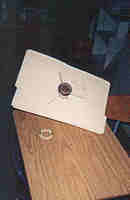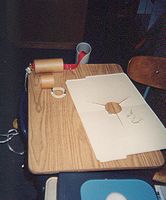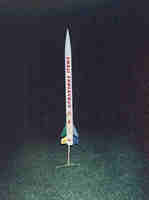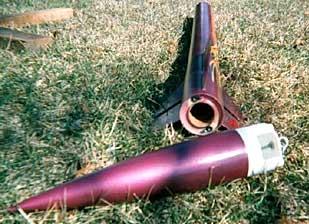Public Missiles Small Endeavour
Public Missiles - Small Endeavour
Contributed by Brian Sutton courtesy of WildRocketry.Com
| Manufacturer: | Public Missiles  |
A couple of months ago, Charlie, the owner of HobbyTown USA in Brea, CA told me he was bringing in PML kits I started getting excited. I told him to hold on to a Pterodactyl Jr. for me (See Kerry's review of the kit). When they came in, I opened the shipping box for Charlie and pulled out the Pterry (sorry Kerry). I found the kit easy to build and very sturdy. I liked it so much I went out and bought a PML Small Endeavor kit.
The Small Endeavor is also a straight forward PML kit. If you have ever built a kit by this company you will know what I mean. It features six precut G10 fins, pre-slotted Quantum tubing, a very sturdy 38mm engine mount, piston ejection, tubular nylon shock cord, and a 30 inch ripstop nylon chute with spill hole. ( I can personally attest to the strength of these kits as last week the Pterry forgot her ejection charge and tried to drill for water in the nearby dry riverbed. The only damage was a ruined paint job and a loose fin).
First thing I did, after checking to make sure that all parts were there, was to sand the entire Quantum tube inside and out in the fin can area to make sure the epoxy would adhere properly. I then test fit the Motor mount and fins to make sure everything fit together well. I built the motor mount/ shock cord assembly per the instructions, with no modifications. (To protect the shock cord from ejection, I will put a bit of wadding on top of the motor tube before loading the piston). Make sure you don't glue the rear centering ring on at this time. At this point, I installed the "T" nuts for the motor retention system. I used 6/32 threads as this is standard for most of my high power models. I have two sets of the Giant Leap retention systems and I share them amongst the different models. By installing the nuts now, I can screw in the cap screws now, this makes pulling the ring out much easier later when reinforcing the fin joints on the inside of the tube and on the motor tube.
Before epoxying the fins in place you need to prepare them. First, sand the root edge area to making sure it is clean, smooth and straight. Make sure you wipe any dust off. Rough up the area were the fin will contact the main airframe too. G10 fins are very thin, some people will sand a leading edge, but I just rounded the leading and trailing edges. Again, before epoxying, make sure ALL areas are dust free. I have discovered that Epoxy, fiberglass and plastic shavings and dust LOVE to stick to surfaces due to static. A damp towel usually will dissipate the static charge and clean the dust off.
 |
With the motor mount and forward centering ring epoxied in
place, and the aft ring in place but not glued, it is time to epoxy the fins in
place. I cut a jig out of thin card board (see the illustration). I glued each
fin in place one at a time using 5 minute epoxy, making sure the jig is holding
the fin perfectly straight. After the epoxy had set, I pulled the rear ring out and applied generous Fillets on the motor tube fin joint and the inside airframe fin joint using 30 minute epoxy. Finally, I epoxied the rear ring in place making sure the retention screws did not line up with the fins. |
| One of the biggest changes was in the Piston assembly, I have heard about short pistons jamming so I replaced the 2 inch piston sleeve with a 4 inch sleeve. (As you can see in the picture, you may also notice the rear centering ring with "T" nuts and screws ready to be installed. The fin jig sits to one side.) |  |
 |
After installing the recovery harness, in is time to prepare
for Paint. I sanded the entire model with extra fine sand paper first, then two
coats of Krylon Gray Sandable Primer sanding in between. I like to give my
projects nicknames from good books and this one is named "Rainbow
Six" so each of the six fins would be a different color of the rainbow. I
gave the entire airframe a coat of Gloss White Krylon, wet sanded then another
coat of white. Finally, each fin received a different color. After a quick buff, I put on the stickers and three coats of clear and she's ready to go. |
I'm going to put her up a 29mm reload the first time, we'll see how she does.
I wonder if I can talk Kerry into a Drag race of "bullet proof" Pterodactyls, then our Small Endeavors?

(Contributed - by Dick Stafford)
 Brief:
Brief:
The Small Endeavour is a simple single stage rocket designed for G - I motors.
It is based on PML's Quantum Tube, has a 38mm motor mount, uses piston
ejection, and sports a cool split-fin design.
Construction:
Parts list:
1 - Pre-slotted Quantum Tube airframe
1 - Nose Cone
3 - Lower G-10 fins
3 - Upper G-10 fins
1 - Piston subassembly, including
1 - Phenolic piston body
1 - Nylon piston strap (~4 ft)
1 - Slotted plywood bulk plate
1 - Metal D-ring
1 - 30" ripstop nylon conical parachute
1 - 38mm x 10" phenolic motor tube
2 - 3/16" plywood centering rings
1 - Heavy elastic shock cord (~ 9 ft)
1 - 1/4" brass launch lug
The Small Endeavour came packaged in a plastic bag. I immediately checked that all the parts were present and reviewed the instructions. What struck me first was the mirror-smooth finish on the Quantum Tube. It almost looks too good to paint!
As in many HPR kits, the instructions are brief. In addition to the main instruction sheet, there were individual instructions for the piston subassembly, preparation of the Quantum Tube, and the chute. The piston instructions included an important discussion on the amount of black powder that should be used as an ejection charge. On the down side, the instructions should have addressed the fit (snugness) of the piston. I have to point out that PML provides a lot of additional information on their WEB site (FAQs, specs, motor selection charts, RockSim files) and has a support representative who monitors the r.m.r. newsgroup. Anyone with web access can get answers to any construction or flight question. I promptly got an answer to my piston question and have since learned that the PML kits now include more info from the FAQ and identify the web address.
Out of the bag, the nose cone and piston did not fit into the Quantum Tube. I sanded the inner edge of the tube and they then fit snugly. The CRs and fins fit perfectly.
I constructed the MMT as noted in the instructions except for the following two tweaks. I recessed the front CR by 1" vs. the 0.25" noted in the instructions. This way the leading edge of the front fin tab rests against this CR. On the rear CR, I added some small T-nuts for motor retention.
As noted in the instructions, I sanded all areas that had to be glued, including the inner and outer fin fillets. I then installed the MMT and fins pretty much per the instructions. To ensure their alignment, I installed the upper and lower fins at the same time. I clamped the pairs of fins together using a plastic ruler and two 3/8" binder clips. The T-nuts provided an easy way to remove the rear CR, which was not glued in until after the fins (including inner fillets) are completed.
As mentioned earlier the fit of the piston body was very snug. PML recommends that their pistons "should slide easily in or out with just a little push or pull". I sanded the piston until I thought it met PML's criteria. However, the only way to know if I sanded it enough is to try it.
I installed Blacksky rail guides in place of the provided brass lug. One of the rail guides is installed immediately above the rear CR and the other is immediately below the forward CR.
Finishing:
While thinking about painting, I noticed there were no decals in my kit. The
PML web site claimed that there should have been so I shot an email off.
Evidently, my kit was produced before the decals were provided. No problem -
three days later they were here.
In preparation for finishing, I wiped the QT with rubbing alcohol, lightly sanded it, and wiped it down a second time. I also filled the nosecone seams and the flaws in my fillets with SuperFil from Shadow Composites. SuperFil is a light epoxy filler that is very easy to sand. I used 3 coats of Krylon white primer, sanding between each coat, and two cans of Testors Burgundy Purple Metal Flake applied in four thin coats.
The self adhesive decals were not easy to install. In order to fit the flames and the "Small Endeavour" text as shown on the PML web site, I had to cut out the clear decal material from between the outer legs of the flame. These outer legs had to overlap the fillets. Also, these decals really grab hold (this is probably a good thing in the long run). I didn't get the last section where I wanted it. However, it wasn't too bad and since I was scared it would lift the paint, I left it where it was.
Construction Rating: 4 out of 5
 Flight:
Flight:
I couldn't use the commercial motor clips that I already had because there is
not enough room between the motor mount and body tubes. Instead, I fashioned a
clip from coat hanger wire and some electrical bayonet-style terminal lugs. I
place the end of the wire through the barrel of the lug and bend a 1/8"
section at a 90 degree angle. I then bend the foot of the lug the opposite
direction, make the proper bends so the wire conforms to my Giant Leap 29mm -
38mm adapter with a SU G80 installed, and repeat the termination procedure at
the other end. The adapter had the same shoulder dimensions as a RMS casing.
This way the retainer holds both a RMS casing and a SU motor in the adapter.
This procedure doesn't always result in the prettiest retainer, but is easy and
has always worked for me.
The maiden flight was on 3/10/2001 in Middletown, MD at the NARHAMS launch (my thanks to the hosts!). It was quite windy so I opted for a G35-7 to keep the flight low. My home-made Igniterman igniter worked perfectly. The Small Endeavour arched into the wind and because of the trajectory, the ejection was quite late. However, the recovery was perfect and there wasn't a scratch on the rocket. The piston worked fine despite my worries.
I plan to fly it on a G80 next and then, hopefully, a new H242 "Redeye" reload (turning blue while holding my breath). Watch for updates in the flight logs.
Recovery:
I decided to keep the strap elastic shock cord. It is stronger than the average
elastic, it should not come in contact with the ejection gas, and the rocket is
not very heavy. I looped the elastic over on itself about two inches and sewed
it.
The 30" conical panel chute is made of heavy rip-stop nylon and has a large (5") spill-hole. It appears to be of above average quality for this size chute. I added an eyebolt to the nose cone and used quick-links to connect the shock cord to the nose cone and piston. Finally, I used a heavy duty swivel that I obtained from Giant Leap to connect the chute to the shock cord. The added weight should not be an issue on this rocket and the recovery components are now removable.
As I said earlier, the ejection on the first flight was late. Although it was quite windy, the spill-hole in the chute kept the drift down. It appeared that a larger chute should be used, especially if the terrain is rough.
Flight Rating: 5 out of 5
Summary:
Overall this rocket went together easily. The QT and piston took a bit more
work than the other simple HPR kits that I've built, but that isn't necessarily
a bad thing. The question is whether these items were worth the effort. The
bottom line is that I don't think I have enough experience to pass final
judgment. The QT provided a great finish, but I don't know how it will hold up
over time. The piston worked for me, but I've only lit one motor in it.
Nevertheless, here are the PRO's and CON's of this kit based on my experience
to date:
PRO's:
The kit used high quality components (sturdy NC, G10-fins, QT airframe). The QT
provided a great finish. Although the instructions themselves could have been
better, the excellent online data and support more than made up for them. No
wadding needed, easy flight prep.
CON's (all minor issues):
Decals were missing, but they were easily obtained from PML. Piston
instructions were unclear. Although the online FAQ provides guidance, it is not
perfectly clear as to how snug the fit should be. The elastic shock cord -
however, this is a common issue with every entry-level HPR kit I've built.
Overall Rating: 5 out of 5
Other Reviews
- Public Missiles Small Endeavour By Al Casper
Public Missiles - Endeavour review is provided courtesy of: PML's Small Endeavor, featuring the Quantum Tube Assembly, Quantum Tube Tests, Finishing, Launch By: Al Casper Public Missiles is now offering the new Quantum body tubes in several of their kits. The tubes are gray in color and made from a special blended polymer. PML claims you can drop it, squeeze it, even throw it, ...
 |
 |
Flights
 |
 |
T.L. (January 1, 2001)
J.S.G. (October 2, 2001)
S.R. (January 26, 2002)
 |
 |
G.G. (July 1, 2000)